Physical Address
304 North Cardinal St.
Dorchester Center, MA 02124
Physical Address
304 North Cardinal St.
Dorchester Center, MA 02124
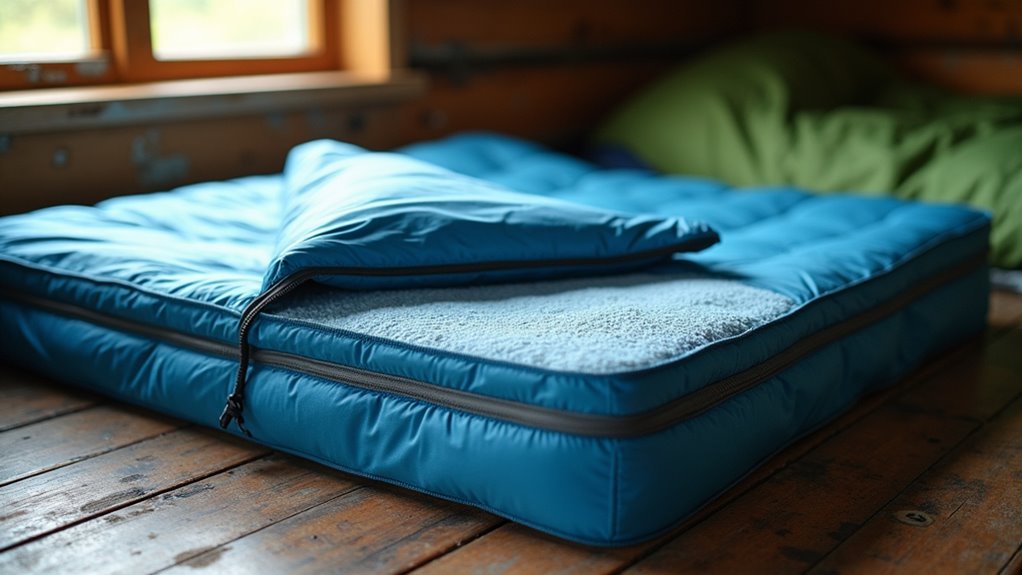
Key factors in choosing the perfect camping mattress can make or break your outdoor adventure - discover what experts recommend.
You’ll face countless options when searching for a camping mattress, and making the wrong choice can lead to sleepless nights in the wilderness. While basic foam pads might save you money upfront, they won’t always deliver the comfort and insulation you need for changing seasons and terrain. Understanding key features like R-values, material durability, and inflation systems will help you invest in a mattress that matches your camping style and budget.
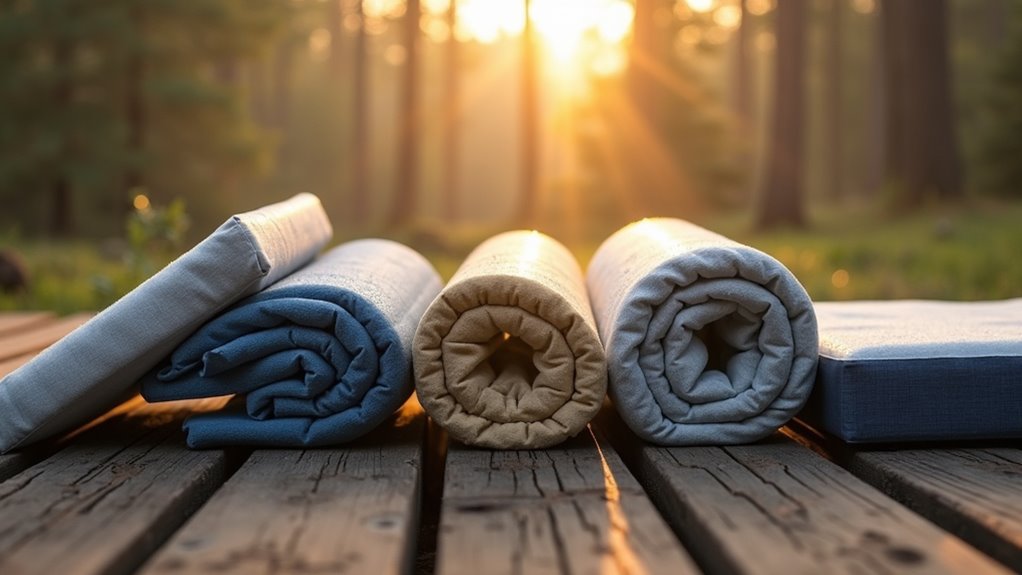
Choosing the right camping mattress can make or break your outdoor experience. The main types each serve different camping needs and comfort levels.
Air pads offer the best packability and weight savings, making them ideal if you’re backpacking. With some models having R-values up to 10.6, they can provide excellent insulation even in cold conditions. Essential Sleeping Bags for Your Next Outdoor Adventure can also help keep you warm during chilly nights.
Self-inflating pads combine foam and air for easier setup and good comfort, though they’re slightly heavier.
If you’re looking for indestructible simplicity, closed-cell foam pads are your most budget-friendly option, but they’re bulkier to pack.
For car camping where space isn’t an issue, consider air beds or cots. These provide home-like comfort but aren’t practical for backcountry trips.
Specialty mattresses, like hybrid designs, offer unique features such as integrated pumps or modular sections – but you’ll typically pay more for these conveniences.
While selecting the right type of mattress sets the foundation, the specific comfort features will determine how well you actually sleep outdoors.
Look for brushed polyester surfaces and knit materials that won’t make noise when you move. You’ll want at least 4 inches of thickness with foam core support to prevent feeling the ground beneath you. Vertical sidewalls keep you centered on the mattress instead of rolling off. The Therm-a-Rest MondoKing 3D offers an excellent balance of these key comfort features.
For temperature control, check that your mattress offers adequate insulation and compatibility with your sleeping bag. You’ll appreciate one-way valves that let you adjust firmness to your liking. Top Camping Mats can provide additional insights on the best options for your outdoor adventures.
Don’t overlook the packed size – you’ll need something that fits in your backpack without taking up too much space. If you’re sharing, consider wider options that give you enough room to move without disturbing your partner.
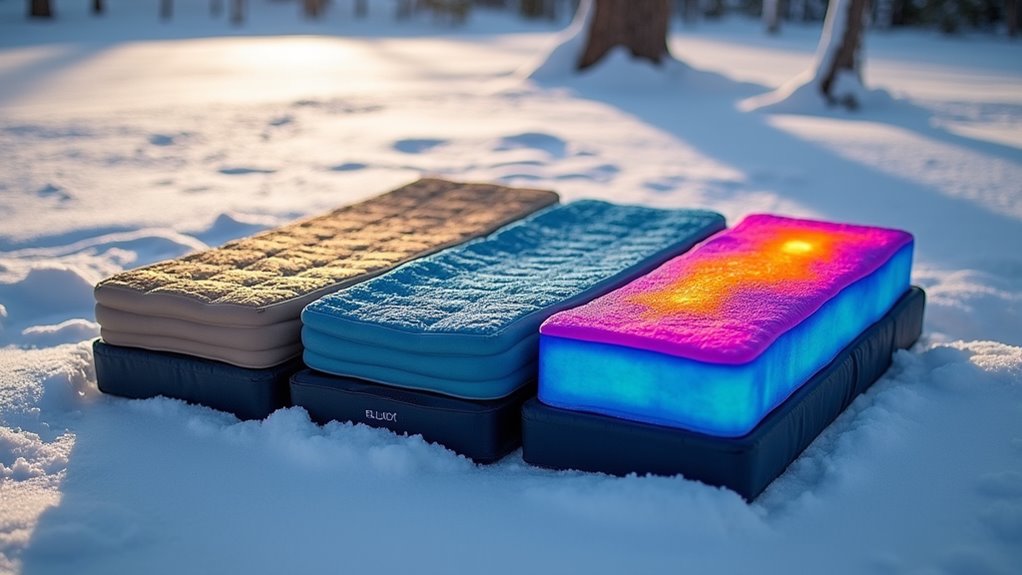
The R-value of your camping mattress directly impacts how warm you’ll sleep outdoors. Higher R-values mean better insulation against cold ground, with ratings typically ranging from 1 to 7 on camping pads.
For summer camping above 10°C, you’ll do fine with an R-value between 0.5 and 2.0.
Choose R-values of 2.0 to 3.5 for cool weather down to 5°C.
If you’re winter camping, don’t settle for less than 4.0 to 5.0. Thanks to standardized testing methods, you can now reliably compare R-values across different brands. Camping air beds are must-haves for outdoor comfort.
Since camping styles vary dramatically, your mattress weight requirements will differ based on how you plan to use it.
For car camping, you can prioritize comfort with heavier options like the 7.5-pound Exped MegaMat 10 Duo, as you won’t be carrying it far. Self-inflating pads offer an excellent balance of comfort and convenience for vehicle-based camping. Choosing the right camping sleeping bag can also enhance your comfort and warmth while car camping.
However, if you’re backpacking, you should aim to keep weight minimal with closed-cell foam pads or lightweight inflatable options like the 1.6-pound Therm-a-Rest NeoLoft.
Lightweight backpackers need ultralight sleeping solutions – closed-cell foam pads and inflatable mattresses keep your pack weight down while ensuring restful nights outdoors.
Ultralight backpackers should consider shortened pads or minimalist closed-cell foam options to save weight.
If you’re camping as a couple, you can share the load of a duo mattress, but consider whether the combined weight is practical for your needs.
For general camping, focus on finding a balance between comfort and portability that matches your specific camping style.

Choosing durable camping mattress materials can save you money and frustration in the long run. For the best durability, look for closed-cell foam pads or self-inflating mattresses with reinforced edges and double-stitched seams.
If you’re considering an inflatable mattress, check for TPU coatings and high-denier polyester fabrics (50D or higher) that resist punctures and abrasion. Products like the Exped MegaMat feature durable materials that maintain their integrity even after extensive use. Comfortable Camping Air Beds can provide a restful night’s sleep outdoors.
Pay attention to environmental protection features. You’ll want UV-resistant materials and water-resistant coatings to prevent degradation from sun exposure and moisture.
For rough terrain camping, prioritize models with abrasion-resistant bottom surfaces and integrated valve protection.
While ultralight mattresses are tempting, they often sacrifice durability for weight savings. If you’re planning frequent use, it’s worth investing in heavier, more robust materials that’ll withstand repeated camping trips.
When planning your camping setup, understanding mattress dimensions can make or break your comfort level.
You’ll find RV twins ranging from 28″ to 40″ wide, perfect for solo sleepers, while RV fulls at 53″ x 75″ work well for couples. If you’re dealing with tight spaces, consider a three-quarter mattress at 48″ x 75″. These specially designed mattresses are lighter and thinner than regular mattresses, typically weighing under 100 pounds. Essential camping gear can also impact your mattress choice.
For larger RVs, you’ve got more options. RV kings come in various sizes, including 70″ x 74″ and 72″ x 80″, while the RV short queen at 60″ x 75″ offers a good compromise between space and comfort.
If you’re camping in a truck, look for mattresses around 42″ x 80″.
Remember to measure your sleeping area carefully before buying – there’s nothing worse than discovering your new mattress doesn’t fit your space.
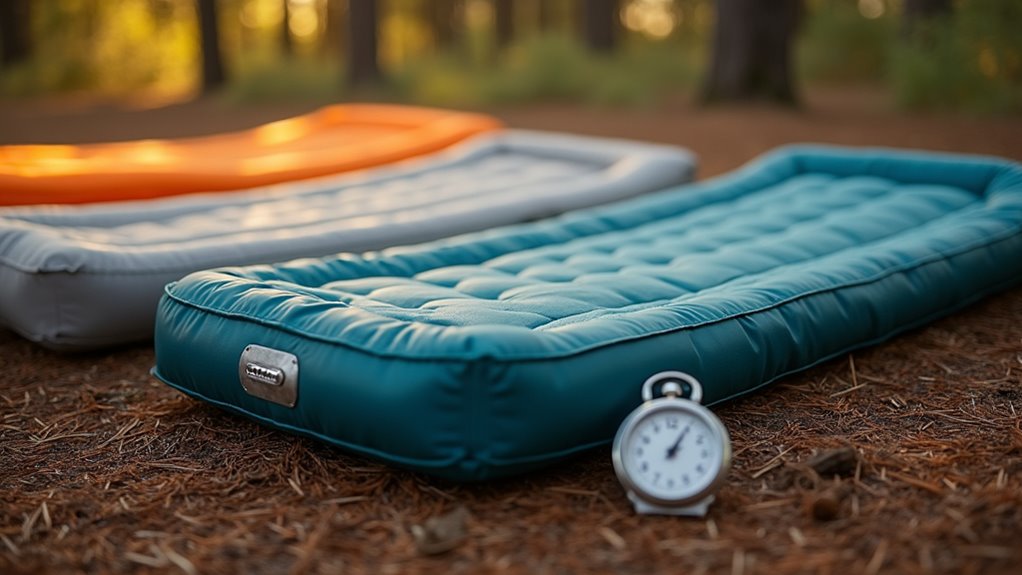
Whether you’re setting up camp at dusk or racing against incoming weather, your mattress’s inflation method can make a big difference in getting settled quickly.
Self-inflating pads offer the fastest setup, requiring minimal effort as they expand automatically. You’ll just need a few breaths to top them off.
Air pads take longer to inflate but give you control over firmness. If you don’t want to spend time manually inflating them, invest in a pump-bag valve systems – they’ll cut your setup time considerably. The pump-bag valve systems allow for fine-tuning the air level to your preferred comfort.
For reliability, closed cell foam pads need no inflation at all, though they’re bulkier to pack. Essential Camping Gear for Every Outdoor Adventure can provide more insight into the different types of camping mattresses.
Remember to check for leaks before your trip, and keep your valves clean. Well-maintained inflation systems will guarantee you’re not wasting precious campsite time on troubleshooting.
Proper storage and transportation can double your camping mattress’s lifespan. Store your mattress in a dry, room-temperature closet or under your bed, away from sunlight and damp areas like basements or garages.
Before storing, clean the mattress with mild soap and verify it’s completely dry to prevent mold. For major spills or stains, use biodegradable soap to avoid damaging the material. Let it deflate naturally, then roll it from the valve side rather than folding it to avoid stress on the seams. If you’re storing long-term, keep the valve open for airflow.
Always use the manufacturer’s storage bag to protect against dust and damage. Essential gear for your next camping adventure can help ensure your camping mattress lasts for many trips.
When transporting, secure your mattress in your vehicle with retention bars or straps. Don’t overcompress it in stuff sacks, and choose clean, flat surfaces when setting up or packing to prevent punctures.
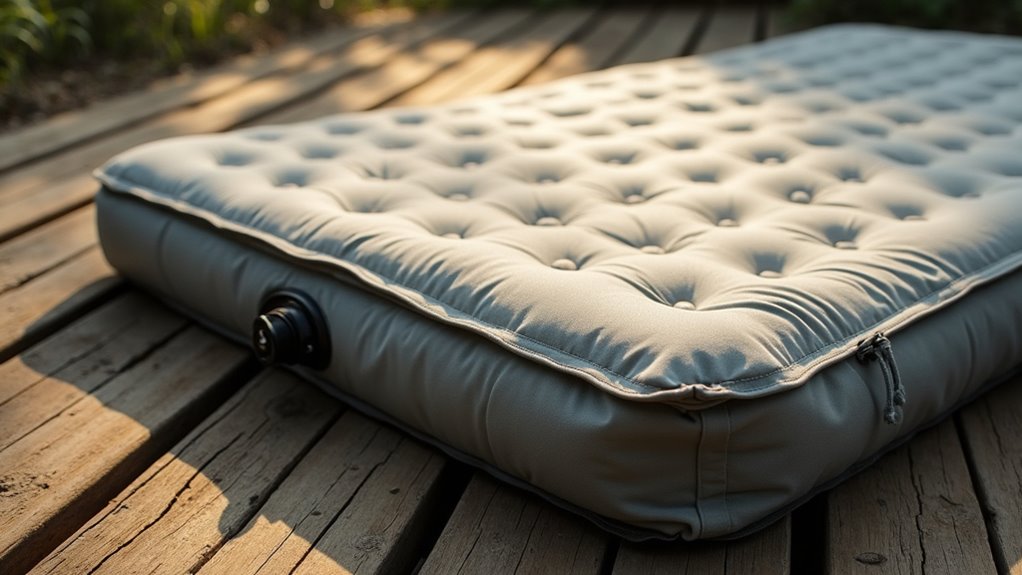
Regular maintenance of your camping mattress prevents costly damage and extends its life considerably. Start by inspecting it before and after each trip for signs of wear or punctures.
Clean the surface with lukewarm soapy water and a cloth, paying special attention to the valves. Never machine wash or use harsh chemicals. Gaffa tape or duct tape can provide temporary fixes for small punctures in the field.
Store your mattress properly based on its type – keep self-inflating models unrolled with open valves, while air mattresses can be tightly rolled.
Always guarantee it’s completely dry before storage to prevent mold. Use a groundsheet for protection and keep pets away from the mattress.
Don’t leave it in direct sunlight, and check inflation levels regularly to avoid damage. Keep a repair kit handy for quick fixes, and perform thorough inspections at least once per season. Proper knife handling is important to avoid damaging your camping mattress during maintenance.
Selecting a camping mattress that matches your seasonal needs can make or break your outdoor experience.
For summer camping, you’ll want a lightweight pad with a low R-value (1-2), focusing on breathability and comfort rather than insulation.
Spring and fall require medium R-values (2-4), where self-inflating or insulated air pads offer the right balance of warmth and portability. The egg-shell pattern design in many pads enhances ground insulation during these transitional seasons.
Winter camping demands high R-value pads (4.5+) to protect you from frozen ground. Look for thick foam or well-insulated air pads with R-values of 7 or higher. Essential winter camping boots are crucial for your adventures during this season.
For wet conditions, choose closed-cell foam or waterproof-coated pads that resist moisture.
In windy environments, verify your pad has adequate insulation and durability to withstand abrasion.
The key is matching your pad’s features to when and where you’ll be camping most often.
Whether you’re sleeping under desert stars or nestled in mountain snow, your choice of camping mattress makes the difference between waking refreshed or stiff and grumpy. You’ll need to balance comfort against portability – thick foam provides luxury but weighs you down, while ultralight air pads pack tiny but cost more. Choose based on your camping style, prioritize durability within your budget, and don’t skimp on proper maintenance.